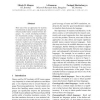Free Online Productivity Tools
i2Speak
i2Symbol
i2OCR
iTex2Img
iWeb2Print
iWeb2Shot
i2Type
iPdf2Split
iPdf2Merge
i2Bopomofo
i2Arabic
i2Style
i2Image
i2PDF
iLatex2Rtf
Sci2ools
NAACL
2010
2010
Everybody loves a rich cousin: An empirical study of transliteration through bridge languages
Most state of the art approaches for machine transliteration are data driven and require significant parallel names corpora between languages. As a result, developing transliteration functionality among n languages could be a resource intensive task requiring parallel names corpora in the order of n C2. In this paper, we explore ways of reducing this high resource requirement by leveraging the available parallel data between subsets of the n languages, transitively. We propose, and show empirically, that reasonable quality transliteration engines may be developed between two languages, X and Y , even when no direct parallel names data exists between them, but only transitively through language Z. Such systems alleviate the need for O(n C2) corpora, significantly. In addition we show that the performance of such transitive transliteration systems is in par with direct transliteration systems, in practical applications, such as CLIR systems.
Computational Linguistics | NAACL 2010 | Names Corpora | Parallel Names Corpora | Transliteration Systems |
| Added | 14 Feb 2011 |
| Updated | 14 Feb 2011 |
| Type | Journal |
| Year | 2010 |
| Where | NAACL |
| Authors | Mitesh M. Khapra, A. Kumaran, Pushpak Bhattacharyya |
Comments (0)

